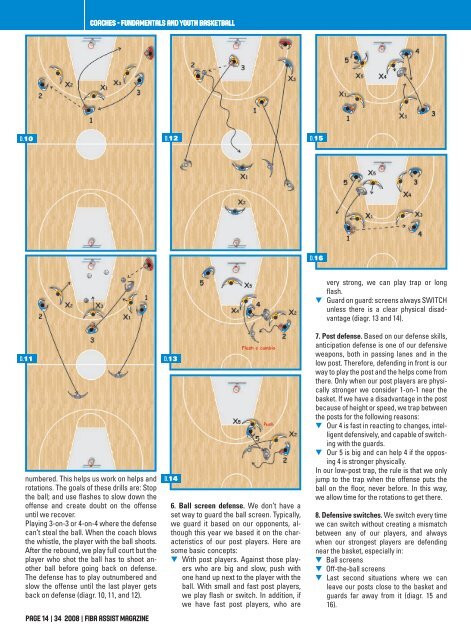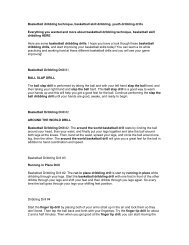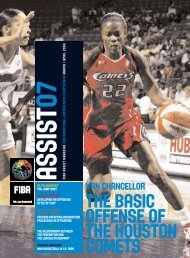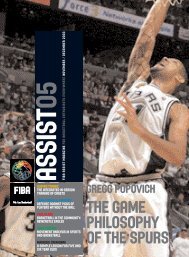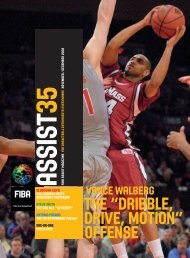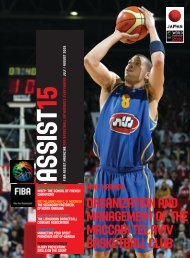“SLICE” AND “POINT” SETS - FIBA.com
“SLICE” AND “POINT” SETS - FIBA.com
“SLICE” AND “POINT” SETS - FIBA.com
Create successful ePaper yourself
Turn your PDF publications into a flip-book with our unique Google optimized e-Paper software.
D.10<br />
numbered. This helps us work on helps and<br />
rotations. The goals of these drills are: Stop<br />
the ball; and use flashes to slow down the<br />
offense and create doubt on the offense<br />
until we recover.<br />
Playing 3-on-3 or 4-on-4 where the defense<br />
can’t steal the ball. When the coach blows<br />
the whistle, the player with the ball shoots.<br />
After the rebound, we play full court but the<br />
player who shot the ball has to shoot another<br />
ball before going back on defense.<br />
The defense has to play outnumbered and<br />
slow the offense until the last player gets<br />
back on defense (diagr. 10, 11, and 12).<br />
D.12<br />
D.11 D.13<br />
page 14 | 34 2008 | Fiba Assist Magazine<br />
COACHES - FUNDAMENTALS <strong>AND</strong> YOUTH BASKETBALL<br />
D.14<br />
6. Ball screen defense. We don’t have a<br />
set way to guard the ball screen. Typically,<br />
we guard it based on our opponents, although<br />
this year we based it on the characteristics<br />
of our post players. Here are<br />
some basic concepts:<br />
▼ With post players. Against those players<br />
who are big and slow, push with<br />
one hand up next to the player with the<br />
ball. With small and fast post players,<br />
we play flash or switch. In addition, if<br />
we have fast post players, who are<br />
D.15<br />
D.16<br />
very strong, we can play trap or long<br />
flash.<br />
▼ Guard on guard: screens always SWITCH<br />
unless there is a clear physical disadvantage<br />
(diagr. 13 and 14).<br />
7. Post defense. Based on our defense skills,<br />
anticipation defense is one of our defensive<br />
weapons, both in passing lanes and in the<br />
low post. Therefore, defending in front is our<br />
way to play the post and the helps <strong>com</strong>e from<br />
there. Only when our post players are physically<br />
stronger we consider 1-on-1 near the<br />
basket. If we have a disadvantage in the post<br />
because of height or speed, we trap between<br />
the posts for the following reasons:<br />
▼ Our 4 is fast in reacting to changes, intelligent<br />
defensively, and capable of switching<br />
with the guards.<br />
▼ Our 5 is big and can help 4 if the opposing<br />
4 is stronger physically.<br />
In our low-post trap, the rule is that we only<br />
jump to the trap when the offense puts the<br />
ball on the floor, never before. In this way,<br />
we allow time for the rotations to get there.<br />
8. Defensive switches. We switch every time<br />
we can switch without creating a mismatch<br />
between any of our players, and always<br />
when our strongest players are defending<br />
near the basket, especially in:<br />
▼ Ball screens<br />
▼ Off-the-ball screens<br />
▼ Last second situations where we can<br />
leave our posts close to the basket and<br />
guards far away from it (diagr. 15 and<br />
16).


